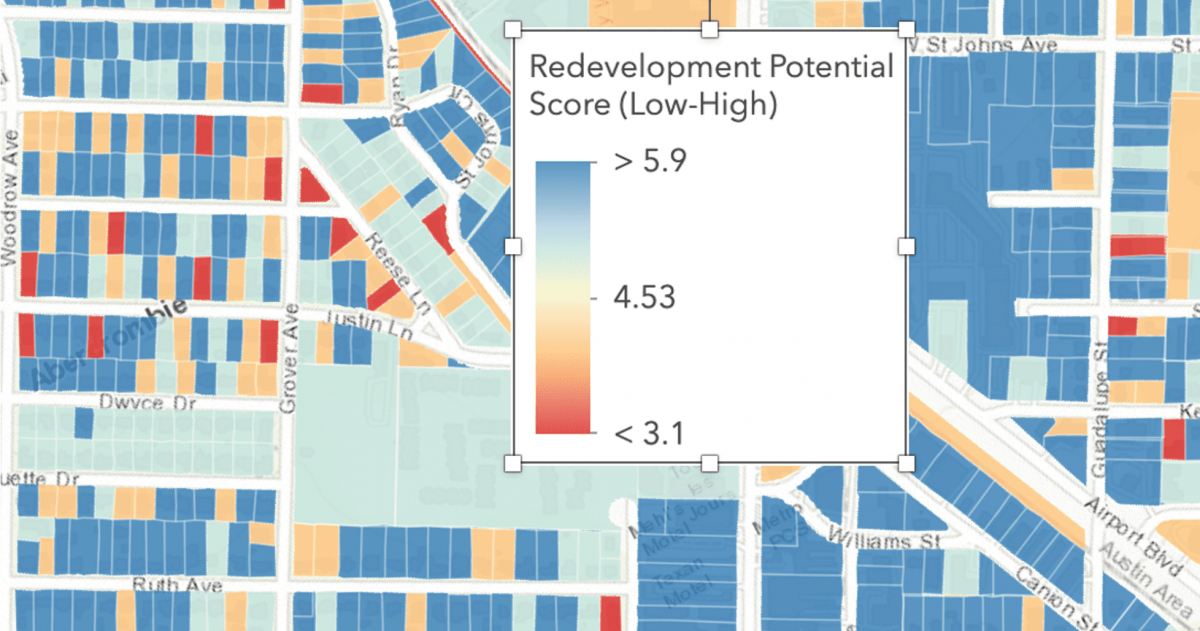
KEY POINTS:
- As part of its new eTOD plan, the City of Austin has scored thousands of area homes for “redevelopment potential”
- The plan proposes more than 100 eTOD districts throughout the city, each a mile wide
- According to local officials, one of the plan’s measures of success is the “number of multi-unit developments built on lots that were previously zoned as single-family only”
The City of Austin wants you to believe its Equitable Transit-Oriented Development (eTOD) Policy Plan is designed to improve local train and bus service.
In reality, City Hall’s eTOD plan is another rezoning and redevelopment scheme, just like CodeNEXT—and now we have the proof.
As this newly unearthed document shows, city officials have quietly mapped single-family neighborhoods impacted by eTODs and categorized individual homes according to “redevelopment potential.” Homes color-coded as blue have high redevelopment potential, yellow have moderate redevelopment potential, and red have low redevelopment potential.
As we’ve reported, City Hall’s plan proposes more than 100 eTOD districts throughout Austin. Residents can search for addresses using this map to see if their properties are within one or more eTODs. (NOTE: Some users may have difficulty loading the map in Google Chrome and are encouraged to try Safari or an alternative web browser.)
If the plan is approved and the targeted amendments are initiated and approved, the properties within each eTOD district would have interim regulations applied and be subject to an eTOD zoning overlay .
According to the plan’s authors, one of its measures of success is the “number of multi-unit developments built on lots that were previously zoned as single-family only.”
City Hall’s eTOD plan raises a host of important questions:
- Our municipal staff have asked the Austin City Council to act fast on the plan. Why? Do they want it approved before local residents discover what’s happening to their properties and neighborhoods?
- Instead of adding a few eTODs on the light rail lines that are likely to be built, City Hall has proposed the majority on bus lines, which less permanent than rail. Why?
- 18 years ago, Austin ambitiously added nine TOD districts to the Land Development Code, but only three have been developed. What is the justification for suddenly adding more than 100 to the list?
- San Jose, California, is roughly the same size as Austin and has five TODs. Los Angeles has ten times the population and has 10 TODs. Again, why does Austin suddenly need to add more than 100?
Families and other property owners in all parts of town are impacted by City Hall’s eTOD plan—but, as usual, the first effects will be felt on the city’s East Side, with four rail and eight bus eTODs. True to form, the city has not notified these or any other homeowners of the proposed zoning changes to come.
This stealth effort to rezone Austin is antidemocratic and wrong.
Contact Austin Mayor Kirk Watson using the information below and let him know you strongly oppose the proposed eTOD plan. Send him this simple message: “Mayor, reject the eTOD plan and direct city staff to limit eTOD planning to locations on rail lines that will actually be built.”
Together we can build an Austin for everyone!
Mayor Kirk Watson:
kirk.watson@austintexas.gov | 512-978-2100